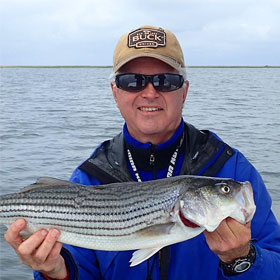How to Rig and Fish a Curly Tail Grub
By Ken Schultz
Mar 17, 2021
What to know about rigging the versatile and popular curly tail jig, different methods of retrieval, as well as the freshwater and saltwater species to catch
A lot of anglers would say that if they just had one lure to use to survive and catch a fish on, it would be a jig with a curly tail grub.
What’s a Curly Tail Grub?
Also referred to as a curl tail jig, or a grub fishing lure, a curly tail grub is a lure with a rounded soft plastic body and a thin curved tail that wiggles when retrieved. The body is predominantly ribbed, but may be smooth. It usually has a single tail, but some versions have opposing double (or “twin”) tails.
The term ”curly tail grub” generally refers to lures that vary from under an inch to 3 inches in length, but much larger versions are produced. This soft plastic lure is overwhelmingly fished with a leadhead jig, but it can also be attached to many hooks and other types of lures, particularly spoons, spinners, and spinnerbaits.
What You Can Catch with a Curly Tail Grub
An almost endless list of predatory freshwater and saltwater gamefish can be caught on a curly tail grub. In freshwater, crappies, yellow perch, bluegills, and assorted other sunfish top the list, but largemouth and smallmouth bass, walleye, trout, stripers, pike, and pickerel are also prime catches. The list in saltwater is even greater, topped by striped bass and flounder, but including spotted seatrout, snook, bonefish, bluefish, croaker, spot, weakfish, many groupers and snappers, and a host of bottom dwellers.
How to Rig a Grub
For best results, and to get the proper action out of a grub, it’s important to rig it right. When properly rigged the body should lay flat and straight, not bunched or twisted, along the hook shank, with the head of the grub snug to the back of the jig head. Most people, myself included, prefer to have the upward curl of the tail aligned with the upward bend of the jig hook.
Starting with the center of the head, thread the hook through the middle of the grub, bringing the point out at a location that allows the entire hook shank to be covered.
In all jig fishing it‘s best to use the lightest weight that you can to cast effectively and to reach the level you need to fish. Match the size of the grub (overall length and body thickness) to the size and weight of the jig head. Smaller versions, such as 1-inch grubs, are best for small species like crappie and perch, while 3-inch versions produce better for bass, walleye, and larger species.
How to Use a Curly Tail Grub
There are primarily two methods of retrieving a jig with a curly tail grub: swimming and jigging. Trolling is also possible, but casting provides better control over speed and depth.
Swimming is very simple and entails a slow and steady turn of the reel handle with the rod tip low. An occasional twitch can be imparted, but keep a slow pace.
Jigging takes on two forms: cast-and-lift and dropping vertical. After casting, let a jig fall to the bottom and then lift your rod tip to hop the jig off the bottom and slightly toward you while also retrieving slack line. Keep repeating as the lure returns to you. Vary jigging action and speed.
In deeper locations, open the bail on your reel and let a jig drop to the bottom or to a specific depth, close the bail, and pump the rod tip lightly to let the lure lift and fall. Most strikes occur on the fall.









